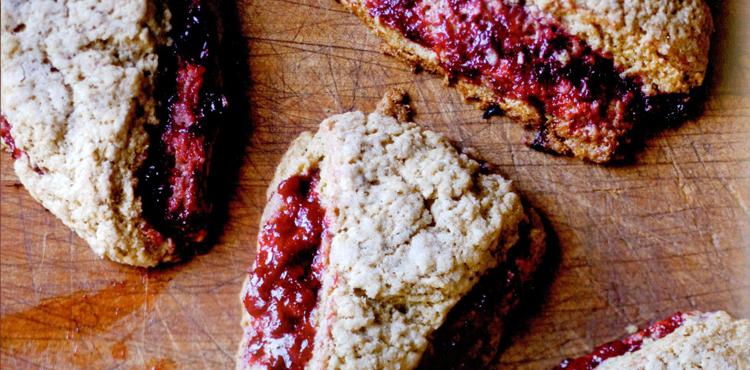Active time
20 minutesTotal time
45 minutesYield
8 sconesServing Size
1 sconeNutrition
Share This
Ingredients
Butter for the pan
For the Dry Mix
1 cup plus 2 Tbsp barley flour
1 cup all-purpose flour
¼ cup dark brown sugar
2 tsp baking powder
½ tsp baking soda
1 ¼ tsp. kosher salt
For the Wet Mix
4 ounces (1 stick) cold unsalted butter
½ cup buttermilk
1 egg
For the Finish
½ cup strawberry jam or marmalade
1 Tbsp unsalted butter, melted
1 Tbsp sugar
Instructions
- Place a rack in the center of the oven and preheat to 350°F. Rub a baking sheet lightly with butter. Sift the dry ingredients into a large bowl, pouring back into the bowl any bits of grain or other ingredients that may remain in the sifter.
- Cut the butter into ½-inch pieces and add them to the dry mixture. Use your hands to rub the butter between your fingers, breaking it into smaller bits. Continue rubbing until the butter is in sizes ranging from rice grains to flattened peas. The more quickly you do this, the more the butter will stay solid, which is important for the success of the recipe.
- In a small bowl, whisk together the buttermilk and egg until thoroughly combined. Scrape the buttermilk and egg into the dry mixture, and mix until barely combined.
- Use a pastry scraper or a spatula to transfer the dough onto a well-floured surface. The dough may be too sticky to handle; if it is, dust it with flour and fold it together a few times. Divide the dough into 2 pieces. Flour your hands and pat each piece of dough into a disk about ¾ inch thick and 7 inches in diameter.
- Cover one disk with the jam or marmalade. Top the spreaded disk with the other disk and press down gently so that the dough settles into the jam. Brush the dough lightly with melted butter and sprinkle with sugar. Use a sharp knife to slice the circle into 8 triangular wedges, like a pie. Carefully place the wedges on the baking sheet, leaving a few inches between them.
- Bake the scones for 22 to 26 minutes, rotating the sheets halfway through. The scones are ready when their tops are golden brown and some of the jam or marmalade has bubbled over onto the pan. To keep the scones from sticking to the pan, slide a thin spatula underneath them while they’re still warm and move them to a baking rack. The scones are best eaten warm from the oven or later that same day.
Note: Resist the temptation to add more flour to the dough than you need – it should be sticky but manageable. A generously floured surface will help these scones come together.
Recipe and photo courtesy of Kim Boyce, author of Good to the Grain: Baking with Whole-Grain Flours.
Nutrition
Calories: 320Total Fat: 15g
Saturated Fat: 9g
Sodium: 530mg
Carbohydrate: 44g
Fiber: 3g
Total Sugars: 15g (Added Sugar: 8g)
Protein: 5g


How'd it Taste?
Review this Recipe